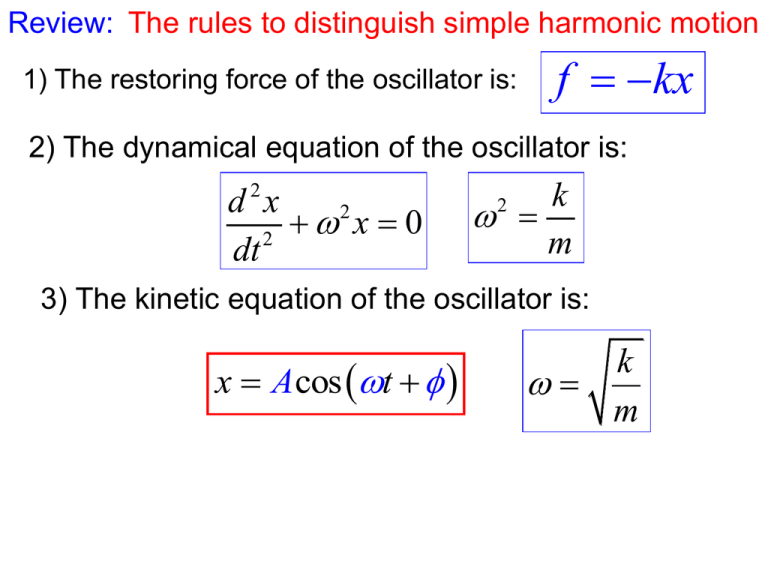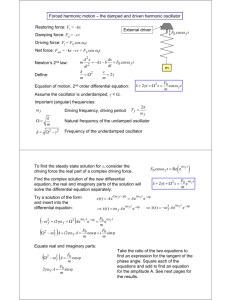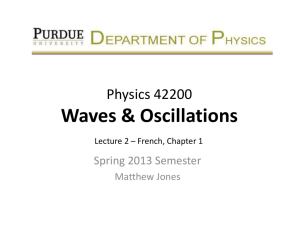Chapter 2
advertisement

Review: The rules to distinguish simple harmonic motion 1) The restoring force of the oscillator is: f kx 2) The dynamical equation of the oscillator is: d 2x 2 x0 2 dt k m 2 3) The kinetic equation of the oscillator is: x A cos t k m Amplitude A, Period T/ Frequency f, phase constant φ 2 m T 2 k 1 1 f T 2 k m The period and the frequency depend only on the mass of the particle and the force constant of the system. m Determine the frequency of the following simple harmonic vibration: 1 1 f T 2 k1 k m Fnet k1 k2 x kx 1 1 f T 2 k 1 m 2 k1 k2 m k k1 k2 k2 The forces on the two springs are: f1 k1 x1 f 2 k2 x2 k1 k2 m The forces on the vibrator is: f kx The displacement of the vibrator is: f f1 f 2 We have: k k1 k 2 x x1 x2 The forces on the spring 1, spring 2 and the vibrator are equal. k1 k2 m k1k2 k k1 k2 The frequency of the simple harmonic vibrator is: 1 f 2 m 1 k 2 m k1 k2 k1k2 The characters of simple harmonic motion 1) Simple harmonic vibration is periodic motion 2) The state of the oscillator is determined by the parameters of amplitude A, angular frequency ωand phase angle φ. 3) ω is determined by the natural quantities of the system. A andφare determined by the system and the initial condition of the system. Example 1-1-1 A particle moves along x axis in simple harmonic motion. Its amplitude A=0.12m, period T=2s. When t=0, its displacement is x(0)=0.06m, moving to the positive direction of the equilibrium position. Find: 1) The kinetic equation of the simple harmonic motion. 2) t=T/4, the position, velocity and acceleration of the particle. 3) The time to arrive the equilibrium position for the first time. solution 1) the kinetic equation of the particle is: x A cos t T 2s A 0.12m 2 rad / s T x (0) 0.06m A cos 0.12 cos cos 1/ 2 1 3 The velocity of the vibrator: dx v A sin t dt v (0) A sin 0 1 3 sin 0 1 3 Thus, the kinetic equation of the particle is: x (t ) 0.12 cos t 3 2)t=T/4, the position, velocity and acceleration of the particle the kinetic equation of the particle is: x (t ) 0.12 cos t 3 dx the velocity of the particle is: v 0.12 sin t dt 3 dv 2 0.12 cos t the acceleration of the particle is: a dt 3 Take t=T/4=0.5 s into the above equations, we get: x 0.104m v 0.189m / s a 1.03m / s 2 3) When the vibrator arrives the equilibrium position, the displacement is 0. We get: 0 0.12 cos(t t 3 3 ) ( 2k 1) 2 For the first time, t is minimum. t 5 6 0.83s , k 1, 2, x (cm ) Example 1-1-2 The simple harmonic vibration curve (cosine form) of a vibrator is shown in the right diagram. Try to get its kinetic equation. 2 1 t (s ) 0 1 2 1s solution the kinetic equation of the particle is: x A cos t A 0.02m x (0) A cos 0.02 cos 0.01 cos 0.5 2 3 x (cm ) 2 1 ?? t (s ) 0 1 2 2 x (1) A cos t 0.02 cos 3 2 2 3 4 3 1s 0.02m 4 2 x 2 cos( t ) 3 3 The energy consideration simple harmonic motion 1 2 1 1 2 2 2 2 2 Ek mv mA sin t kA sin t 2 2 2 1 2 1 2 E p kx kA cos2 t 2 2 1 2 E Ek E p kA 2 Ek E ( 0) E Ek E p E E p Ek A 0 T 4 T 2 3T 4 T o Ep A t 1. The amplitude and frequency of Ek and Ep are identical, but the phase angle is opposite. 2. The mechanical energy of the vibrator is proportional to A2. The average kinetic energy of simple harmonic vibration 1 Ek T T 0 1 2 mv dt 2 1 T1 1 2 1 2 2 2 mA sin (t )dt kA E T 0 2 4 2 The average potential energy: 1 EP T T 0 1 2 1 kx dt 2 T 1 1 2 kA E 4 2 T 0 1 kA2 cos 2 ( t )dt 2 §1-2 represent simple harmonic vibration by rotating vector method The kinetic equation of the simple harmonic vibrator x A cos t The simple harmonic vibration can be expressed by Rotating vector. X axis is vibration axis M O is the equilibrium position The magnitude of vector A is identical with the amplitude A. The vector A is rotating vector. o t A x A cos(t ) The angular speed ωis the angular frequency of the vibration. Φ: the initial phase / phase angle. The displacement of the vibrator away from the equilibrium position is the projection of vector A on x axis. The three parameters of simple harmonic vibration are expressed by rotating vector method M o t A A cos(t ) x the velocity of the vibrator: v R A the direction of the velocity is negative when 0<ωt+φ<π the acceleration of the vibrator: an R A 2 2 a x an cos(t ) A cos(t ) 2 A cos(t ) 2 v a x an A O x Example 1-1-3 A particle moves along x axis in simple harmonic motion. Its amplitude A=0.12m, period T=2s. When t=0, its displacement is x(0)=0.06m, moving to the positive direction of the equilibrium position. Find: the kinetic equation of the simple harmonic motion. Solve it with rotating vector method 2 x0 0.06m T v (0) 0 1 3 x (t ) 0.12 cos t 3 O A 0.12m x Rotating vector method M The three parameters of simple harmonic vibration are expressed by rotating vector method o t A A cos(t ) x the velocity and the acceleration of the vibrator in rotating vector method: v a x an A O x a>0 X>0 v>0 §1-3 damped oscillations The simple harmonic vibration is the simplification model of an ideal frictionless system. In realistic systems, resistive forces, such as friction and viscous force, are present and retard the motion of the system. The mechanical energy of the system diminishes in time. The restoring force of simple harmonic vibration is: F kx The restoring force of damped oscillation is: F kx Fresis t ive If the resistive force is proportional to the velocity and acts in the direction opposite the velocity: Fresis t ive bv 2 dx d x F kx bv kx b m 2 dt dt d 2x dx m 2 b kx 0 dt dt If the resistive force is small, b 4mk Solve the differential equation x(t ) Ae b t 2m cos t The oscillatory character of the motion preserved. 2bm t x(t ) Ae cos t The amplitude of the vibration decreases with time. The vibration ultimately ceases. Underdamped oscillator x Ae b t 2m t The angular frequency of the underdamped oscillation: b 2m 2 2 0 k m 2 0 If b=0, there is no resistive force and the system is simple harmonic vibration. If b=2mω0, ω=0. The system does not oscillate. Critically damped x The vibrator returns to equilibrium in an exponential manner. t If b>2mω0, the medium is highly viscous. x The system does not oscillate but simply returns to its equilibrium position. overdamped As the damping increases, the time it takes the particle to approach the equilibrium increases. When a resistive force is present, the mechanical energy of the oscillator decreases, and falls to zero eventually. t §1-4 forced oscillations The mechanical energy of a damped oscillator decreases in time as a result of resistive force. The diminished mechanical energy is possible to be compensated by applying an external force that does positive work on the system. If the external force varies periodically F (t ) F sin t 0 Note: The angular frequency of the external force / driven force is different from the natural frequency ω0 of the oscillator The net force on the oscillator: Fnet Fdriven kx bv Connecting with Newton’s law: 2 d x dx m 2 F0 sin t b kx dt dt Solve the differential equation: The amplitude A: x(t ) A cos t F0 / m A 2 2 2 0 b m 2 ω0 natural frequency / Resonance frequency When 0 , the amplitude A arrives its maximum Resonance Resonance: the oscillating system exhibits its maximum response to a periodic driving force when the frequency of the driving force matches the natural frequency of the oscillator. The kinetic equation of the forced oscillation / steady forced vibration is: x(t ) A cos t It is a harmonic vibration. §1-5 superposition of harmonic vibrations superposition Superposition of motions Superposition of vibrations We will focus on Case : superposition of harmonic vibrations with identical frequency and common vibration axis 1) Superposition of two harmonic vibrations with identical frequency and common vibration axis x1 A1 cos t 1 The net vibration: x2 A2 cos t 2 x x1 x2 A: rotating vector method A The amplitude A of net vibration: A A A 2 A1 A2 cos2 1 2 1 2 2 A2 ))φ 2)ψ )φ A1 y 1 The initial phase angle of the net vibration: O A1 sin 1 A2 sin 2 tg A1 cos 1 A2 cos 2 1 x x The angular frequency of net vibration is identical with that of the two components. Thus, the kinetic equation of the net vibration is: A2 x A cos t A A A 2 A1 A2 cos2 1 2 1 2 2 A1 sin 1 A2 sin 2 tg A cos A cos 1 2 2 1 1 )ψ O A A1 x Resume simple harmonic motion 1) The restoring force f kx 2 2) The dynamical equation d x 2 x 0 2 dt 3) The kinetic equation x A cos t k m x A cos t dx v A sin t dt dv 2 a A cos(t ) dt xmax A vmax A amax A 2 x A cos t Simple harmonic motion: Damped oscillation, the resistive force: x(t ) Ae b 2 m 2 0 2 b t 2m Fresis t ive bv cos t k m 2 0 Underdamped oscillator b is very small x Ae Critically damped b=2mω0, ω=0 x b t 2m t overdamped b>2mω0 t x t Steady forced oscillations The external periodic force F (t ) F0 sin t The net force on the oscillator: Fnet Fdriven kx bv x(t ) A cos t F0 / m A 2 2 2 0 When 0 b the amplitude A arrives its maximum m Resonance 2







